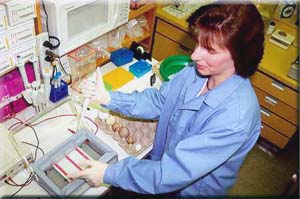May 25, 2009
Surveying The Experts On The Dangers Of Common Chemicals: Some Surprising Findings Emerge

By Michael D. Shaw
Have you ever wondered what real scientists think about the seemingly endless parade of bad news regarding chemicals in the environment? So did Dr. Robert Lichter, president of the Center for Media and Public Affairs (CMPA) at George Mason University. To get answers, CMPA teamed up with the Society of Toxicology, and presented an online questionnaire to 3,562 of its members.
While 1136 members did respond, the findings—released on May 21, 2009—were based on the responses of those 937 members who answered every question.
Lichter felt that it was important to get scientific opinion based on an expert community at large, as a counter to the opinions of the small circle of authorities often quoted in the media. Indeed, a 1997 study conducted by the Roper Center for Public Opinion Research found that media scientists portrayed so-called xenoestrogens as being a definite cause of harm to human health in 62 percent of the cases. This was vastly different, however, from the opinion of a random sample of distinguished scientists, who—again in 62 percent of the cases—characterized the threat of xenoestrogens as either “minor” or “none.”
The inescapable conclusion is that the media, ever in search of bad and alarming news, tends to quote those who give them what they want, even if this is far from the expert consensus.
Thus, the finding in CMPA’s survey that toxicologists almost unanimously believe that the media does a poor job covering basic scientific concepts and explaining risk. To wit…
- 90% say media coverage of risk lacks balance and diversity
- 97% say the media doesn’t distinguish good studies from bad studies
- 96% say the media doesn’t distinguish correlation from causation
- 96% say the media doesn’t explain that “the dose makes the poison.”
- 74% believe the news media pays too much attention to individual studies as opposed to the overall evidence
- 68% believe the news media pays too much attention to studies put out by environmental groups
While the toxicologists might be skeptical of the media in general, some of them—too many in my book—still succumb to the popular culture’s notion of what constitutes risk, science or no science:
- 26% believe cosmetics pose a significant health risk
- 55% believe pesticides pose a significant health risk
- 48% peg Bisphenol A (BPA) as a medium or high health risk
- 47% peg high-fructose corn syrup as a medium or high health risk
One can only conclude that such beliefs must be heavily influenced by the popular media. After all, beyond iffy epidemiological studies on hair dye use and certain cancers, and underarm deodorant use and breast cancer, there really are no cross-sectional epi studies on other cosmetics that could support such a negative opinion. Likewise, even though some BPA-containing products have been banned in a few jurisdictions, the science behind such actions is contentious, at best.
As to high-fructose corn syrup, the toxicologists are correct to be concerned about its possible implications in the current epidemic of obesity, but are wrong to label a particular ingredient, that is safe in itself, as a health risk. If most processed foods contain too much salt, should salt—an essential nutrient—also be termed a health risk?
The pesticides finding is strange. Other data in the study show the members almost equally divided on DDT, the historically libeled and now mostly reprieved baddie, originally maligned by Rachel Carson. Here again, exactly what sort of scientific studies can they cite to form such an opinion? They speak of balance and diversity. How would they propose to feed billions without pesticides?
The members tend to hold such environmental activist fund-raising groups as Greenpeace, PETA, the Environmental Working Group, and the National Resources Defense Council in low esteem, which prompted Linda Greer, NRDC’s Director, Health and Environment Program, to react during the press conference held to announce the survey. Greer—apparently unfamiliar with survey methodology—noted that the results were not peer reviewed. If the results and methodology of a survey are to be published in a journal, then they are peer reviewed. Otherwise, a survey stands on its own, subject to the informal peer review of the media.
Lichter couldn’t resist asking Greer if her organization ever releases data without peer review. She replied (as quoted by Reason magazine) “We’re an advocacy group and we don’t hold ourselves out as scientific researchers. We don’t do peer reviewed science. Everybody knows that.”
Perhaps the most disturbing finding concerns how scientific information is disseminated to the public, and for that matter, to the scientific community. 64% of those surveyed agree that the peer review system is politicized. That would surely go a long way in explaining how efforts which would not have passed muster as a high school science project 30 years ago, now appear in prestigious journals.

